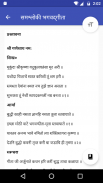






Bhagavad Gita in Marathi भगवद्गीता

Descrição do Bhagavad Gita in Marathi भगवद्गीता
समश्लोकी भगवद्गीता is the Marathi language translation of Bhagavad Gita by Sadashivrao Paranjape. Krishna explains to Arjuna why a just war must be fought, nature of life, and the paths to moksa. This treatise is present in Bhisma Parva, and known as Bhagavad Gita. It is a 700-verse Hindu scripture that is part of the Hindu epic Mahabharata.
Bhagvad Gita is set in a narrative framework of a dialogue between Pandava prince Arjuna and his guide and charioteer the god-king Krishna. Facing the duty to kill his relatives, Arjuna is counselled by Krishna to "fulfill his Kshatriya (warrior) duty as a warrior and kill." Inserted in this appeal to kshatriyadharma (heroism) is "a dialogue between diverging attitudes concerning and methods toward the attainment of liberation (moksha)".
भगवद्गीता हा प्राचीन भारतीय ग्रंथ आहे. त्यात भगवान श्रीकृष्णांनी अर्जुनाला जीवनाबद्दल केलेला उपदेश आहे. संस्कृत भाषेतील गीतेचे पद्यरूपात मराठी भाषेत रूपांतर करण्याचे अवघड कार्य सदाशिवराव परांजपे यांनी केले.
समश्लोकी भगवद्गीता é a tradução da língua Marathi de Bhagavad Gita por Sadashivrao Paranjape. Krishna explica a Arjuna por que uma guerra justa deve ser combatido, a natureza da vida, e os caminhos para moksa. Este tratado está presente em Bhīṣma Parva, e conhecida como Bhagavad gita. É uma escritura Hindu 700-verso que faz parte do épico hindu Mahabharata.
Bhagvad Gita é definido em uma estrutura narrativa de um diálogo entre Pandava príncipe Arjuna e seu guia e cocheiro do rei-deus Krishna. De frente para o dever de matar seus parentes, Arjuna é aconselhado por Krishna para "cumprir o seu Kshatriya (guerreiro) dever como um guerreiro e matar." Inserido neste apelo à kshatriyadharma (heroísmo) é "um diálogo entre divergentes atitudes sobre e métodos para a obtenção da libertação (moksha)".
भगवद्गीता हा प्राचीन भारतीय ग्रंथ आहे. त्यात भगवान श्रीकृष्णांनी अर्जुनाला जीवनाबद्दल केलेला उपदेश आहे. संस्कृत भाषेतील गीतेचे पद्यरूपात मराठी भाषेत रूपांतर करण्याचे अवघड कार्य सदाशिवराव परांजपे यांनी केले.

























